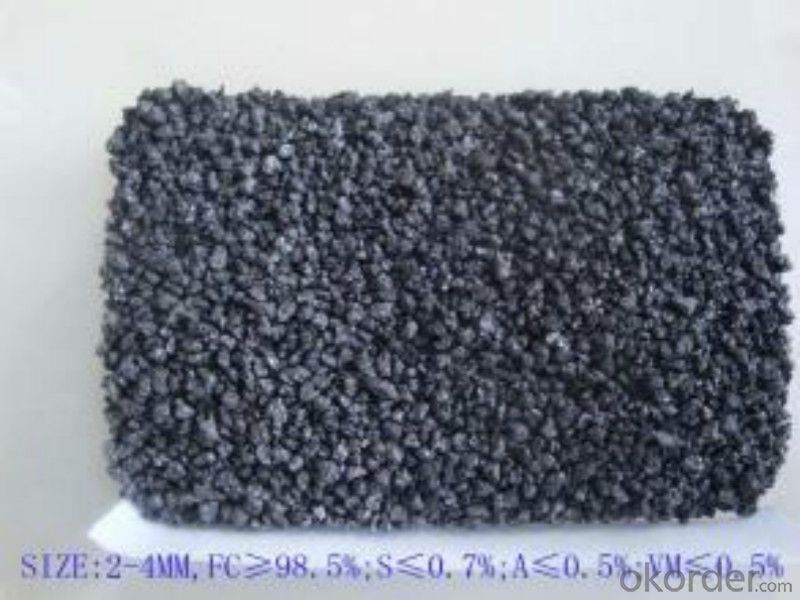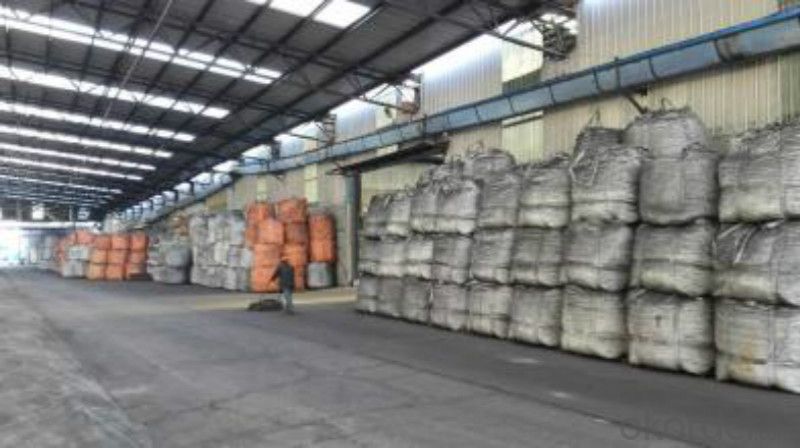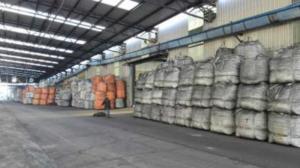Calcined Pitch Coke with size 0-5mm 90%min
- Loading Port:
- Tianjin
- Payment Terms:
- TT OR LC
- Min Order Qty:
- 22 m.t.
- Supply Capability:
- 8000 m.t./month
OKorder Service Pledge
OKorder Financial Service
You Might Also Like
Introduction
Pitch Coke/Coal Tar Pitch is a kind of black brittleness and blocky piece, lustrously at normal temperature. It has special odour and poisonous and can be easily flame when melting, second-grade inflammable solid.
Pitch Coke/Coal Tar Pitch is obtained from powerfully processed coal tar. Compared to petroleum asphalt, the adhesiveness is better. Coal Tar Pitch is high quality tar production with high fixed carbon. It has excellent adhesion, waterproofing and resistance against seawater, oil and various chemicals. In these properties, it is much better than petroleum asphalt tar.
It can be used to produce painting, electrode, pitch coke, and tar felt. It also can be used as fuel and the raw material of asphalt carbon black.
Features:
The morphology, chemistry and crystallinity of recarburisers have a major impact on the overall casting cost. The combined application and cost benefits, which are derived through the use of Desulco, enable foundries to manufacture castings in a highly cost effective manner.
reduces
Recarburiser consumption
Power consumption
Inoculant consumption
MgFeSi consumption
Furnace refractory wear
Scrap rate
Tap to tap time
Slag inclusions risk
Chill
increases
Casting microstructure
Productivity
Process consistency
Carbon Recovery
Compared with calcined petroleum coke, acetylene coke and
graphite electrode scrap, Desulco yields the highest carbon
recovery and fastest dissolution time
Specifications:
CPC | |||
F.C.% | 98.5MIN | 98.5MIN | 98MIN |
ASH % | 0.8MAX | 0.8MAX | 1MAX |
V.M.% | 0.7 MAX | 0.7 MAX | 1 MAX |
SULFUR % | 0. 5MAX | 0. 7MAX | 1MAX |
MOISTURE % | 0.5MAX | 0.5MAX | 1MAX |
Pictures:




FAQ:
1.MOQ:2 Containers |
2.Size:1-3mm,1-5mm,2-6mm,3-5mm and as the customer's requirement |
3.Packing: 1 ton jumbo bag or 25kgs paper in bag |
4.Payment:T/T or L/C at sight |
5.Delivery time: within 15 days after receiving the deposit |
6.Usage: it is as carbon raiser,widely used in steelmaking,casting,casting iron,steel foundry,aluminum metallury. |
- Q:What are the industrial uses of diamonds?
- Due to their exceptional physical properties, diamonds have a wide range of industrial uses. One of the most common applications is in the manufacturing of cutting and grinding tools. Diamond-tipped saw blades, drill bits, and grinding wheels are highly sought after for their superior hardness and abrasion resistance. These tools are in high demand for cutting and shaping hard materials such as concrete, ceramics, and metals. In the electronics industry, diamonds are extensively utilized. They serve as heat sinks in high-power electronic devices and as abrasive materials for polishing and lapping electronic components. The thermal conductivity of diamonds allows them to efficiently dissipate heat, making them ideal for electronic devices that generate a significant amount of heat during operation. Moreover, diamonds play a crucial role in the production of specialized windows, lenses, and prisms used in various scientific and industrial applications. Their optical properties, including high refractive index and low dispersion, make them invaluable for creating precision optics employed in lasers, spectroscopy, and telecommunications. Additionally, diamonds have niche applications in the medical and dental fields. Their exceptional hardness and ability to retain sharp edges make them suitable for surgical tools like scalpels and dental drills. Diamond coatings are also applied to medical implants and prosthetics to enhance wear resistance and biocompatibility. Lastly, the oil and gas industry relies on diamonds for drilling and exploration purposes. Diamond drill bits are capable of penetrating extremely hard rock formations, making them essential for extracting oil and natural gas from deep beneath the Earth's surface. In summary, diamonds have vast and diverse industrial uses, ranging from cutting and grinding tools to electronics, optics, medicine, and even oil and gas exploration. The unique properties of diamonds make them indispensable in numerous industrial applications, contributing to advancements in various fields.
- Q:How does carbon monoxide affect air quality and human health?
- Carbon monoxide, a gas produced when fossil fuels like gasoline, coal, and wood are incompletely burned, is a colorless and odorless substance. It plays a major role in air pollution and has significant impacts on both air quality and human health. Concerning air quality, carbon monoxide is classified as a criteria air pollutant, meaning it is regulated by government agencies due to its harmful effects. When released into the atmosphere, CO combines with other pollutants like nitrogen oxides and volatile organic compounds, resulting in ground-level ozone formation, a key component of smog. High levels of ground-level ozone can cause respiratory issues, particularly for individuals with pre-existing respiratory conditions such as asthma. Moreover, carbon monoxide acts as a potent greenhouse gas, contributing to global warming and climate change. It traps heat in the atmosphere, preventing its escape into space and leading to rising temperatures and altered weather patterns. In terms of human health, carbon monoxide is extremely toxic. When inhaled, it binds to hemoglobin in the blood, reducing its ability to transport oxygen to vital organs and tissues. This can result in various health problems, ranging from mild symptoms like headaches, dizziness, and fatigue to more severe conditions such as chest pain, confusion, and even death. Vulnerable populations, including children, the elderly, and those with pre-existing heart or lung conditions, are particularly susceptible to the detrimental effects of carbon monoxide. Exposure to high levels of carbon monoxide can occur in different settings, both indoors where combustion sources like gas stoves, heaters, and fireplaces are present, and outdoors in areas with heavy traffic or industrial emissions. To mitigate the impact of carbon monoxide on air quality and human health, regulatory measures such as emission standards for vehicles and industrial sources have been implemented. Additionally, raising public awareness through campaigns and utilizing carbon monoxide detectors in homes and workplaces are crucial for detecting and preventing potential exposure to this harmful gas. In conclusion, carbon monoxide significantly impacts air quality and human health. It contributes to air pollution, including the formation of ground-level ozone and greenhouse gas emissions, which have adverse effects on respiratory health, the environment, and climate change. Understanding the sources, effects, and implementing appropriate measures to reduce exposure to carbon monoxide is vital for safeguarding both air quality and human well-being.
- Q:What is carbon coffee fiber?
- The carbon coffee fiber uses the coffee residue left after the coffee and is made into crystal by calcining, then ground into nanometer powder and added to the polyester fiber to produce a functional polyester staple, a coffee carbon fiber. Its main functions are bacteriostasis, deodorization, divergence of negative ions and anti ultraviolet rays.
- Q:What are the impacts of carbon emissions on the stability of mountains?
- Carbon emissions have significant impacts on the stability of mountains. One of the most prominent impacts is the acceleration of global warming, which leads to the melting of glaciers and permafrost. As mountains are home to many glaciers, the increase in temperature causes these glaciers to melt at an alarming rate. This melting can result in the destabilization of mountains, leading to increased landslide and rockfall activity. Furthermore, carbon emissions contribute to the acidification of rainwater. Acid rain can erode the rocks and soil in mountains, weakening their stability. This erosion can lead to slope instability, making mountains more susceptible to landslides and other forms of mass movements. Additionally, carbon emissions contribute to changes in precipitation patterns. Mountain ecosystems heavily rely on a delicate balance of rainfall and snowfall. However, climate change caused by carbon emissions disrupts this balance, leading to altered precipitation patterns. This can result in increased water runoff and a reduction in snowpack, both of which contribute to mountain destabilization. Moreover, carbon emissions have indirect impacts on mountain stability through changes in vegetation patterns. As temperatures rise, plant species may migrate to higher altitudes in search of cooler climates. This can result in the loss of vegetation in lower elevation areas, which play a crucial role in stabilizing slopes and preventing erosion. The absence of plant cover leads to increased soil erosion, leaving mountains more vulnerable to landslides and other erosive processes. In conclusion, carbon emissions have detrimental impacts on the stability of mountains. The acceleration of global warming, acidification of rainwater, altered precipitation patterns, and changes in vegetation patterns all contribute to the destabilization of mountains. It is crucial to reduce carbon emissions and mitigate climate change to protect and preserve these majestic natural formations.
- Q:Iron and steel are different in terms of carbon content
- . An iron carbon alloy with a carbon content of less than 2% is a steel, and a carbon content of more than 2% is called iron. Steel is widely used because of its toughness, elasticity and rigidity. Life is exposed to steel, but people call different. For stainless steel, whether or not the magnet is sucked on or not, as long as the quality standards are met, it is stainless steel. Therefore, from the perspective of metallurgy said, no rust said. The main element of stainless steel corrosion resistance is chromium. If the content of chromium is above 10.5%, the steel will not rust. When smelting, the alloy elements added are different, so there is a difference between the magnet and the suction.
- Q:What are the environmental impacts of burning fossil fuels?
- Burning fossil fuels has significant environmental impacts that contribute to climate change and air pollution. When fossil fuels such as coal, oil, and natural gas are burned, they release greenhouse gases, primarily carbon dioxide (CO2), into the atmosphere. These greenhouse gases trap heat, causing global warming and climate change. The increased concentration of CO2 in the atmosphere is the main driver of global warming, leading to rising temperatures and shifts in weather patterns. This, in turn, results in more frequent and severe natural disasters like hurricanes, droughts, and floods. The melting of polar ice caps and glaciers is also accelerated, leading to rising sea levels, which pose a threat to coastal communities and ecosystems. In addition to climate change, burning fossil fuels releases other harmful air pollutants, such as nitrogen oxides (NOx) and sulfur dioxide (SO2). These pollutants contribute to the formation of smog and acid rain, which have detrimental effects on human health, agriculture, and ecosystems. Furthermore, the extraction and transportation of fossil fuels cause environmental degradation. Activities like mining for coal or drilling for oil can lead to deforestation, habitat destruction, and soil and water pollution. Oil spills from offshore drilling operations have devastating consequences for marine life and ecosystems, as witnessed in incidents like the Deepwater Horizon disaster in the Gulf of Mexico. Overall, the environmental impacts of burning fossil fuels are far-reaching and severe. Transitioning to cleaner and renewable energy sources is crucial to mitigate climate change, reduce air pollution, and safeguard our planet for future generations.
- Q:How many points can Yongan change for 1 carbon coins?
- Every Thursday at 19:00, carbon points change for carbon coins, 19:30 carbon coins exchange gifts
- Q:15CrMo seamless steel tube and carbon plate welding fracture what is the reason?
- That's the problem of too much stress in the welding! 15CrMo material after quenching is very brittle, local high temperature welding, then there is no insulation measures, fast cooling speed caused by the welding part of a slight quenching appear, so the stress concentration caused by cold cracking!It is recommended that the 15CrMo pipe be heated to 150 degrees before welding! Pay attention to heat preservation after welding!If the heat treatment process needs to be welded, the heating rate is 200 degrees /h, rise to 715, holding 1 hours and 15 minutes, the cooling rate is 100 degrees /h, and the air cooling is down to 300 degrees centigrade.
- Q:How does carbon dioxide affect climate change?
- Carbon dioxide (CO2) is a greenhouse gas that plays a significant role in climate change. When released into the atmosphere through natural processes like volcanic eruptions or human activities such as burning fossil fuels, CO2 traps heat from the sun and prevents it from escaping back into space, leading to a phenomenon known as the greenhouse effect. The increased concentration of CO2 in the atmosphere due to human activities, primarily the burning of fossil fuels like coal, oil, and natural gas, has led to an imbalance in the natural carbon cycle. This imbalance has resulted in a rapid increase in global CO2 levels, contributing to the warming of the Earth's surface and the subsequent changes in climate patterns. Since the Industrial Revolution, the burning of fossil fuels has caused a significant rise in atmospheric CO2 levels, increasing the Earth's average temperature. This rise in temperature affects various aspects of the climate system, leading to a range of impacts. One of the most evident consequences of increased CO2 levels is the rise in global temperatures. This temperature increase leads to the melting of glaciers and polar ice, causing sea levels to rise. Rising sea levels pose a threat to coastal areas and low-lying islands, resulting in increased flooding, coastal erosion, and the potential displacement of communities. Furthermore, elevated CO2 levels contribute to more frequent and intense heatwaves, droughts, and wildfires in many regions. These extreme weather events can have detrimental effects on agriculture, water availability, and human health. Carbon dioxide also affects the balance of ecosystems by altering the growth patterns and distribution of plant and animal species. Changes in temperature and precipitation patterns, driven by increased CO2 levels, disrupt the delicate web of life, leading to the loss of biodiversity and the potential extinction of certain species. To mitigate the impacts of CO2 on climate change, reducing greenhouse gas emissions is crucial. Transitioning to renewable energy sources, improving energy efficiency, and adopting sustainable practices are some of the steps that can help reduce CO2 emissions and limit the extent of climate change. Additionally, efforts to restore and protect forests and other natural carbon sinks can help absorb and store CO2, mitigating its effects on the climate.
- Q:What are the impacts of carbon emissions on wildlife?
- Wildlife and their ecosystems are significantly affected by carbon emissions, which have a profound impact on their survival. The release of greenhouse gases, primarily carbon dioxide, into the atmosphere is one of the main causes of climate change, which directly affects wildlife and their habitats. One of the most immediate consequences is the alteration of habitats. The rise in temperature can result in the loss of important habitats like coral reefs, mangroves, and polar ice caps, which are home to various species. This loss can lead to the displacement or extinction of vulnerable species, disrupting entire food chains and ecological systems. Additionally, climate change has a significant influence on the timing and availability of resources for wildlife. Changes in temperature and precipitation patterns can disrupt migration, breeding, and hibernation cycles for many species. This can create mismatches between the availability of food sources and the needs of wildlife, ultimately impacting their survival and ability to reproduce. Carbon emissions also cause ocean acidification, which is detrimental to marine organisms. When carbon dioxide dissolves in seawater, it forms carbonic acid, which lowers the pH of the oceans. This acidity negatively affects marine organisms, particularly those with calcium carbonate shells or skeletons, such as corals, oysters, and certain types of plankton. This disruption in the marine food chain can have cascading effects on other marine species, including fish, birds, and marine mammals. Furthermore, carbon emissions contribute to air pollution, directly harming wildlife. Pollutants like nitrogen dioxide and sulfur dioxide can damage respiratory systems, impairing the health and reproductive success of animals. This is especially harmful to species living in or near urban areas with high pollution levels. In conclusion, carbon emissions have extensive consequences for wildlife. Climate change disrupts habitats, alters resource availability, and contributes to ocean acidification. These changes can lead to the displacement or extinction of species, disrupt entire ecosystems, and jeopardize the health and survival of wildlife. It is crucial to reduce carbon emissions and implement sustainable practices to mitigate these impacts and conserve biodiversity.
1. Manufacturer Overview |
|
|---|---|
| Location | |
| Year Established | |
| Annual Output Value | |
| Main Markets | |
| Company Certifications | |
2. Manufacturer Certificates |
|
|---|---|
| a) Certification Name | |
| Range | |
| Reference | |
| Validity Period | |
3. Manufacturer Capability |
|
|---|---|
| a)Trade Capacity | |
| Nearest Port | |
| Export Percentage | |
| No.of Employees in Trade Department | |
| Language Spoken: | |
| b)Factory Information | |
| Factory Size: | |
| No. of Production Lines | |
| Contract Manufacturing | |
| Product Price Range | |
Send your message to us
Calcined Pitch Coke with size 0-5mm 90%min
- Loading Port:
- Tianjin
- Payment Terms:
- TT OR LC
- Min Order Qty:
- 22 m.t.
- Supply Capability:
- 8000 m.t./month
OKorder Service Pledge
OKorder Financial Service
Similar products
New products
Hot products





























